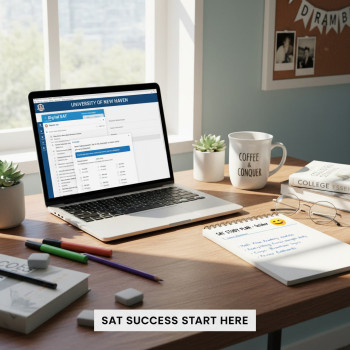Why over-scheduling happens — and why it matters
We want the best for our kids. So when colleges, scholarships, and future opportunities hinge on a standardized test like the Digital SAT, it’s easy to want to cram every possible advantage into an already packed life. The result? A schedule that’s bursting at the seams: school, clubs, sports, volunteer hours, social life, and SAT prep piled on top. Suddenly the very thing meant to increase options becomes a source of stress that shrinks them instead.
But here’s the good news: effective SAT prep isn’t synonymous with more hours. It’s about smarter hours, better recovery, and planning that fits a teen’s actual life. In this post we’ll walk through compassionate, practical ways to prevent over-scheduling while still hitting score goals—complete with sample plans, realistic expectations, and a look at how focused, personalized support (like Sparkl’s 1-on-1 tutoring and tailored study plans) can be folded in without tipping the balance.

Start with priorities, not the calendar
The first mistake most families make is letting a calendar dictate priorities. Flip that around: list what matters most, then design a schedule that serves those priorities.
1. Clarify the true priority list
- Academic performance in current classes (grades matter to colleges and scholarships).
- Long-term well-being: sleep, mental health, social connection.
- SAT target score and timeline (realistic and informed by college choices).
- Extracurricular commitments that matter to the student (leadership roles, sports, arts).
Once these are ordered, you have the compass to reject schedules that force tradeoffs between grades or health and a higher practice-test score.
How much SAT prep is enough? A realistic rule of thumb
There’s no one-size-fits-all, but these rough ranges help set expectations and prevent the “more must be better” trap:
- Minimal prep (review and familiarization): 10–20 hours spread over 4–8 weeks. Good if you already score near target.
- Moderate prep (steady improvement): 40–80 hours over 3–4 months. Typical for students balancing school and activities.
- Intensive prep (significant score gains desired): 100+ hours across 4–6 months, but planned with rest and academic monitoring to avoid burnout.
Quality beats quantity: focused 45–90 minute sessions with specific goals beat marathon study days that leave students exhausted and forgetful.
Designing a balanced weekly SAT plan
Here’s a sample moderate-prep weekly plan that respects school, sleep, and life. It’s built around manageable time blocks and built-in recovery.
| Day | Activity | Duration | Notes |
|---|---|---|---|
| Monday | Focused practice: Reading & Writing (timed passage) | 60 minutes | 1 focused goal (e.g., inference questions). Review mistakes 15 min. |
| Tuesday | School + light review (vocab/app concepts) or rest | 20–30 minutes | Passive practice: flashcards or Khan Academy drills |
| Wednesday | Math practice (concept + mixed problems) | 75 minutes | Work on weak topic (e.g., ratios, algebra) |
| Thursday | 1-on-1 tutoring / targeted review | 45–60 minutes | Use time with tutor for strategy, not just content |
| Friday | Practice test (short section) or rest | 30–60 minutes | End week with lower intensity to recharge |
| Saturday | Full practice test (every 2–3 weeks) | 3–4 hours | Simulate test conditions; review mistakes afterward |
| Sunday | Active recovery + light review | 0–45 minutes | Sleep in, family time, short review if motivated |
This schedule keeps the weekly SAT time to about 3–6 hours on average for moderate prep, which is sustainable for most students. If a student is juggling athletics or a job, aim for the lower end and lean on high-impact activities like 1-on-1 tutoring sessions.
Signs your teen is over-scheduled (and how to respond)
Parents often miss early warning signs. Catching them fast prevents larger problems.
Common warning signs
- Chronic late nights and daytime sleepiness.
- Declining grades despite “studying more.”
- Emotional changes: irritability, withdrawal, anxiety spikes before tests.
- Loss of interest in previously enjoyable activities.
- Studying without clear goals or simply re-reading notes for hours.
When you spot these, pause the schedule. Sit down with your teen and ask two simple questions: “What’s working?” and “What’s making you tired?” The answers will guide adjustments.
Strategies to avoid over-scheduling—and keep progress steady
1. Block scheduling, not open-ended practice
Set short, well-defined blocks (45–75 minutes) with a single objective. Use a timer. Shorter, goal-directed sessions keep focus high and reduce wasted time.
2. Prioritize high-impact activities
Not all practice is equal. Emphasize:
- Adaptive practice that targets weaknesses (digital tools can help).
- Timed practice under realistic conditions (builds stamina and strategy).
- Targeted review of errors (the highest ROI for improving scores).
3. Schedule rest and non-academic time like it’s part of the plan
Rest increases learning. Build in at least one full downtime block per day and one no-SAT day each week. Treat social time, sleep, and physical activity as essential study tools—not indulgences.
4. Use a calendar with built-in flexibility
Plan in “flex slots” each week—30–60 minute windows reserved for catching up or taking a break. This prevents domino effects when a practice session gets missed.
5. Keep schoolwork the non-negotiable
If grades start slipping, reduce SAT time and reassess the prep strategy. Colleges look at transcripts over time; single-test improvement doesn’t outweigh sustained academic performance.
How families can support without micromanaging
Supportive involvement is a delicate balance: helpful but not hovering. Here’s a parent-friendly approach that preserves a teen’s autonomy while offering structure.
- Have a weekly planning chat—10–15 minutes—to set the coming week’s goals together.
- Encourage a wind-down routine before bed (no screens 30 minutes before sleep if possible).
- Offer practical supports: healthy snacks, a quiet study space, or an accountability check-in.
- Model boundaries: if family calendars are chaotic, involve the teen in prioritizing commitments.
- Validate feelings about the pressure—they don’t always reveal stress until it’s big.
When to add tutoring (and how to do it without over-committing)
Tutoring is high-impact when targeted. The goal is not more hours; it’s smarter hours. Consider these principles:
- Bring in tutoring to address specific weaknesses (e.g., algebra fundamentals, pacing, reading strategies), not as general “more practice.”
- Limit sessions to 1–2 focused hours per week in moderate prep plans—more may be helpful only in short, intensive phases before a test date.
- Use tutors to develop a tailored study plan so at-home practice is focused and efficient, preserving the teen’s time.
For many families, Sparkl’s personalized tutoring works well because it emphasizes 1-on-1 guidance, tailored study plans, and AI-driven insights to pinpoint weaknesses. That kind of targeted support can replace inefficient study time, not add to it—if scheduled thoughtfully.
Practical examples: two realistic case studies
Case A: The Busy Honors Junior
Profile: Junior in honors classes, varsity athlete, club officer. Target: moderate score improvement before fall of senior year.
- Prep plan: 40–60 hours over 5 months—45 minutes twice a week + one Saturday 60–90 minute session every other week.
- Tutoring: One 45-minute tailored session every two weeks focusing on math fundamentals and pacing.
- Outcomes: Sustained grades, steady test improvements, and continued extracurricular participation.
Case B: The Test-Focused Senior
Profile: Senior with lighter course load, working part-time. Target: significant score increase before early application deadlines.
- Prep plan: 80–100 hours over 3–4 months—60–90 minute sessions 4–5 times weekly with a weekly full-section practice.
- Tutoring: Weekly 60-minute 1-on-1 sessions for strategy and error analysis, plus AI-backed practice assignments to maximize each hour.
- Outcomes: Intensive but finite block of work, scheduled to finish before application season, with deliberate rest days to prevent burnout.
Monitoring progress without pressure
Track progress with compassionate metrics:
- Short-term: percent of targeted practice completed, time-on-task consistency, and quality of review (are mistakes being analyzed?).
- Medium-term: practice test score trends and improvement in targeted question types.
- Long-term: stability in school grades and reported well-being.
Interpret practice-test swings carefully. One test is a snapshot; look for upward trends and whether the student is internalizing test-taking strategies.
Tools and resources that save time
Use tools that make practice more efficient:
- Official digital practice tools and full-length practice tests to mirror the Digital SAT experience.
- Adaptive practice platforms that tailor question difficulty to current skill level—this reduces wasted time on content that’s too easy or too hard.
- 1-on-1 tutoring sessions focused on diagnostics and strategy—designed to make independent practice more effective.
When tutoring is chosen carefully, it doesn’t add schedule load—it compresses it, giving better results for fewer hours. Again, a well-structured program like Sparkl that offers expert tutors, customized plans, and AI-driven insights can make each study minute count.
Making decisions about test dates and intensity
Pick test dates based on readiness, not arbitrary deadlines. If application timelines require earlier testing, plan a focused, time-limited prep block and pull back on other nonessential commitments where possible. If deadlines are flexible, prefer a longer, lower-intensity plan that’s less likely to cause burnout.
Final checklist: a family-friendly plan to avoid over-scheduling
- Set realistic prep hours based on current workload and goals (use the rule-of-thumb ranges above).
- Prioritize schoolwork and sleep—these are non-negotiable.
- Schedule specific, short study blocks with clear objectives and recovery times.
- Use targeted tutoring to compress practice time and build efficient habits.
- Build in weekly downtime and one no-SAT day per week.
- Monitor signs of stress; reduce intensity at the first sign of harm.

Parting thought: success is sustainable, not sacrificial
College admissions are important, but teenagers are people first. The best SAT prep respects that reality: it’s strategic, tailored, and protective of long-term well-being. Over-scheduling may produce short-term gains, but it can cost sleep, grades, and mental health—the very things that set students up for success in college and beyond.
Make prep part of a thoughtful life plan. Use focused practice, targeted tutoring, and realistic timelines to help your teen reach their goals without losing the things that matter most. If you decide to bring in outside help, look for programs that emphasize diagnostic-driven instruction and efficiency—where 1-on-1 guidance and tailored study plans help students learn faster, not burn out trying. A smart blend of family support, balanced schedules, and expert coaching will get students to their targets with confidence and calm.
If you’d like, I can help you design a sample weekly schedule for your teen based on their current commitments and target score—tell me the number of hours they currently have for prep, whether they want to include tutoring sessions, and what their upcoming deadlines are.



















No Comments
Leave a comment Cancel